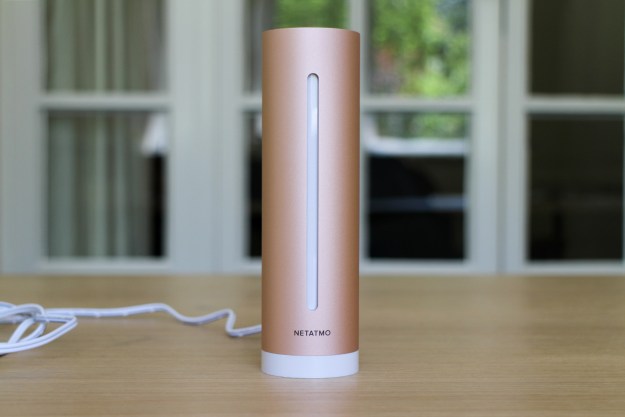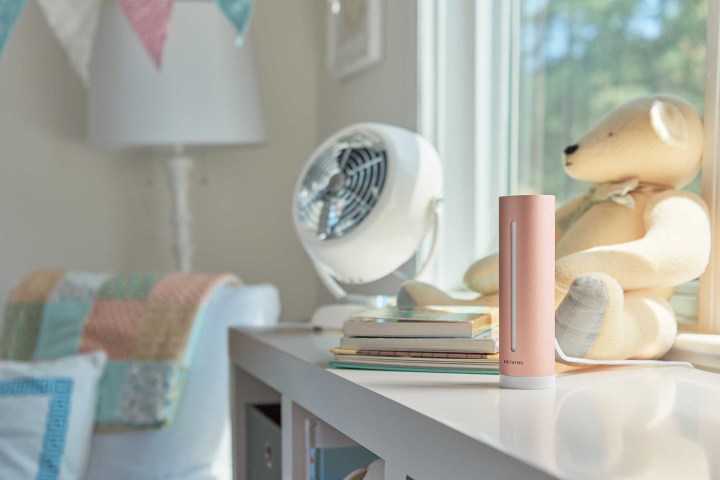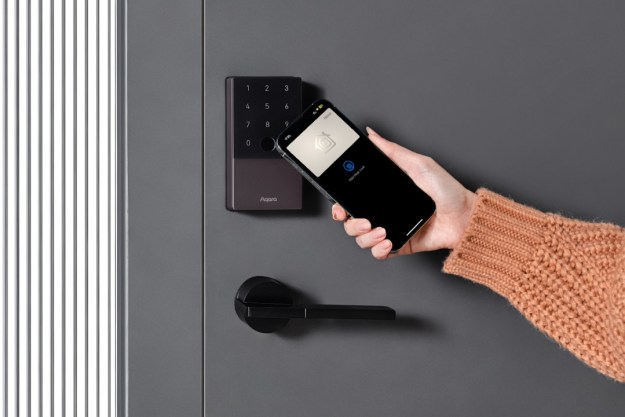
“The Healthy Home Coach keeps you informed about your environment -- and you don’t need a degree to understand the results.”
- Simple to use
- Informative and reliable app
- Attractive design
- Requires no maintenance or lengthy setup
- Questionable helpfulness
- Doesn’t link up with other Netatmo products
Take a deep breath. Now to stop to think about the air you just breathed in. Was it high quality – heck, was it even good for you? Could it be better? If so, what can you do about it? That’s what Netatmo’s latest home gadget is here to tell you. It’s the Healthy Home Coach, and it measures not only the quality of your air but also the temperature, the humidity, and the ambient sound level in a room. Add them all up and you’ve got a picture of how healthy your surroundings are. The Healthy Home Coach isn’t the only device that does this, but like many of Netatmo’s products, it’s an attractive design and is wonderfully simple to use, making it way more desirable than the competition. Our Netatmo Healthy Home Coach review asks a simple question: Should it have a place in your airspace?
Design
The Healthy Home Coach could be easily mistaken for Netatmo’s Welcome indoor home security camera or its Weather Station. It’s an 8-inch high aluminum cylinder bookended by white plastic end caps, with a glowing LED light running down the center of the device. This indicates the status and gives you a quick hint at the air quality. There’s a single MicroUSB connector on the back for power, and the top of the Healthy Home Coach is a touch sensitive panel for activating the LED light.
For a piece of technology, it does a good job of not looking like one. The unusual design won’t be for everyone, though, and there will be some who think it’s a flashy air freshener. Regardless, it blends in with the surroundings way better than a faceless white box nailed to the wall. Put it alongside an Amazon Echo, or particularly the Echo Dot, and judge which you’d rather have on the shelf. We’ll wager the design-led Netatmo will win hands-down.
It’s also solidly made, the rose gold color is very fashionable at the moment, and it’s light enough to unplug and shift around the house — or into another one — at a moment’s notice. It’s the ideal gadget for people who don’t want to see or deal with technology in their home, but do want the benefits it brings.
Using the Healthy Air Coach
Will you have to decode stats, figures, and complicated chemical abbreviations to get the most from the Healthy Home Coach? Thankfully no. You plug it in, and everything else is done in the app, which at the moment is available only for iOS. With other Netatmo products we’ve tested, early versions of apps haven’t been great, and sometimes complicated to use. The Healthy Home Coach’s app isn’t like that. It’s straightforward and clear — and we’ve set the device up on a few different Wi-Fi networks and locations. It hasn’t failed once, and takes less than five minutes. Reliability is a big deal with a device like this.
The app takes care not to overwhelm you with data, and presents everything in a friendly, simple way.
The app takes care not to overwhelm you with data, and presents everything it has to say in a friendly, simple way. The main screen is split in two, with a color coded top panel giving you a quick glance summary of the air quality. This color is also repeated by the device’s front LED. The bottom half gives you exact data on the temperature, humidity, air quality, and sound levels. That’s it, no hyper-detailed readings or baffling science-speak. In the top right, there’s a rewind button that presents hourly data for the previous 24 hours of monitoring, so you can see what’s being going on overnight or in your absence.
While this is helpful, the way it’s presented isn’t great, and could be clearer. Although it refers to the exact hour when it counts back, it uses the letter H as a suffix – H13, or H19, for example. This could be misinterpreted, and we suspect it’s to do with an original French language version (Netatmo is a French company). Once you understand though, it’s obvious the time you’re looking at when scrolling back.
Tap a measurement for an expanded view, but don’t expect to find graphs, long-term data, or anything overly complex. Simplicity is the aim here, and all you get is how your current data compares overall, on a little thermometer-style graphic. It’s perfectly understandable, and you really don’t need anything more. Because the Healthy Home Coach connects to your home Wi-Fi, you can check the data even if you’re not at home.
Netatmo’s app supports Apple HomeKit, so you can ask Siri to give you on-the-spot details about air quality or any of the device’s other stats — this works really well — plus it helps with the Wi-Fi connection. You don’t need to endlessly type in passwords, provided the network is already known on your phone. Again, it’s all very easy. Support for Google Home and Amazon’s Alexa is being worked on, and should be available in the future.
How it works
The Healthy Home Coach is referred to as a “silent product,” which means exactly what you think: the device produces no noise at all, and works without intervention from you. There’s no need to worry about it noise in your bedroom or priming sensors to get the right information or training it for hours to understand your environment.
Temperature, humidity, and sound levels are all measured using the sensors you’d expect. It’ll cope with temperatures ranging from freezing to 122 Fahrenheit (50 degrees centigrade), zero to 100 percent humidity, and from 35db to 120db. If you’re recording the latter in your house, we’ll assume you live inside a jet engine.

To measure air quality, the Healthy Home Coach uses a CO2 sensor. Netatmo told us this is not because CO2 is bad for our health but because it’s a reliable measurement of air quality, and a way to identify underlying issues. While a huge array of figures from many different sensors could give a more detailed idea of air quality, it wouldn’t be very helpful, and certainly not a glanceable record of whether you need to open a window or not. That’s the beauty of the Healthy Home Coach, it just tells you what you need to know, easily and simply.
Does it work?
While we’re writing this, the Home Coach app says our environment is healthy, with a 23.7 degree centigrade (75 degrees Fahrenheit) temperature, 53 percent humidity, 36db of ambient sound, and 482ppm CO2. A window was open in the office, but it wasn’t very wide, which tripped up the Home Coach a bit soon after we plugged it in. Rather than just saying the air quality was poor, the app said we may feel drowsy, or find it hard to concentrate, and that opening a window would help. We opened the window wider, and sure enough, the air quality improved. Drowsiness passed too. It’ll also make suggestions like lowering the humidity (the best dehumidifiers would help), or placing a damp towel in a room to adjust humidity.
[It’s] unobtrusive, and simple to use, but we do question its absolute helpfulness.
It’s best to place the device close to where you spend most of your time, and although it’s not restricted to working in a small area, Netatmo recommends installing different Home Coach devices in different environments. If you live in an open-plan home, you may want one in the kitchen area and one in the living area to ensure accurate readings. We moved the Healthy Home Coach around the house, and into a large open-plan office; it operated with issue after around 30 minutes to adjust to its new situation.
For example, we closed the window and turned on the TV while writing this review. Less than 30 minutes later, the Healthy Home Coach said air quality was deteriorating at 655ppm, temperature was up to 24.1 degrees, and sound is at 51db. None were high enough to trip a notification alert, but when they do get to that point, you’ll get actionable advice on how to improve the situation. It may sound fairly basic, but many lifestyle products — from digital thermometers to fitness bands — just give you the facts, rather than telling you where to make improvements.
The Healthy Home Coach is unobtrusive, and simple to use, but we do question its absolute helpfulness. When I closed the window, I knew it was getting more stuffy without checking the app. And if it’s noisy, my ears do a pretty solid job of letting me know. I also don’t need the app to tell me what to do in either situation. It may have more benefits for anyone who suffers from respiratory problems like asthma, but it can’t predict the environment, only warn you when it’s getting unhealthy. It may also be way more helpful in places where the air quality is already known to be poor. Moderating how much of that poor air is inside the home, and therefore doing something about it, would be highly beneficial.
We’d like to see Netatmo incorporate its own Weather Station — another cylindrical smart monitor, only for outdoor weather use — into the Home Coach, which would increase the product’s overall usefulness. Failing this, it would be great if data from multiple Netatmo devices was collated in a single app, and the results were all put into context with indications on how they affect each other.
Price, warranty, and availability
The Healthy Home Coach costs $100, or 90 British pounds, and can be purchased in Apple stores, through Netatmo’s website, or at retail outlets such as Amazon. Netatmo gives a one-year warranty with its hardware, and will repair or replace a defective item during that time, provided it hasn’t been abused or modified.
Our Take
Air quality affects mood, our concentration, and our health, so understanding it can drastically alter our lives. The Netatmo Healthy Home Coach not only informs us, but also gives advice on how to change things for the better — and looks good while doing it.
Are there better alternatives?
There are many weather stations, CO2 monitors, and environmental devices available to consumers, but none of them look very nice. They’re either a traditional design — characterized by big LCD screens — like those made by Oregon Scientific, or thermostat-style products mostly designed for industrial use. If you want a device that doesn’t look like either of these, Netatmo’s Healthy Home Coach stands almost alone.
How long will it last?
The Healthy Home Coach is made of metal and plastic, so it should survive being knocked off a shelf, and it has excellent build quality. We’ve no reason to think it will fall apart. Provided the app is kept up to date, it should serve you well for many years to come. Netatmo has updated and improved its apps for other products, which bodes well for the future.
Should you buy it?
Yes. The Healthy Home Coach keeps you properly informed, in an easy to understand manner, about a part of our environment that is only becoming more important in terms of our health. If you live in a big, busy city, or in a place where air quality varies drastically, its data may prove invaluable. All this from a neat device which looks great on a shelf in your home. Just don’t expect it to change your life if you already live in a healthy environment.
Editors' Recommendations
- The best smart plugs for Alexa, Google Home, and Apple HomeKit
- Matter adds support for fridges, air purifiers, robot vacuums, and more with massive 1.2 update
- New Yale Assure Lock 2 models get fingerprint scanner, support for Apple Home keys
- The best HomeKit smart blinds of 2023
- Is an air quality monitor worth adding to your home?













